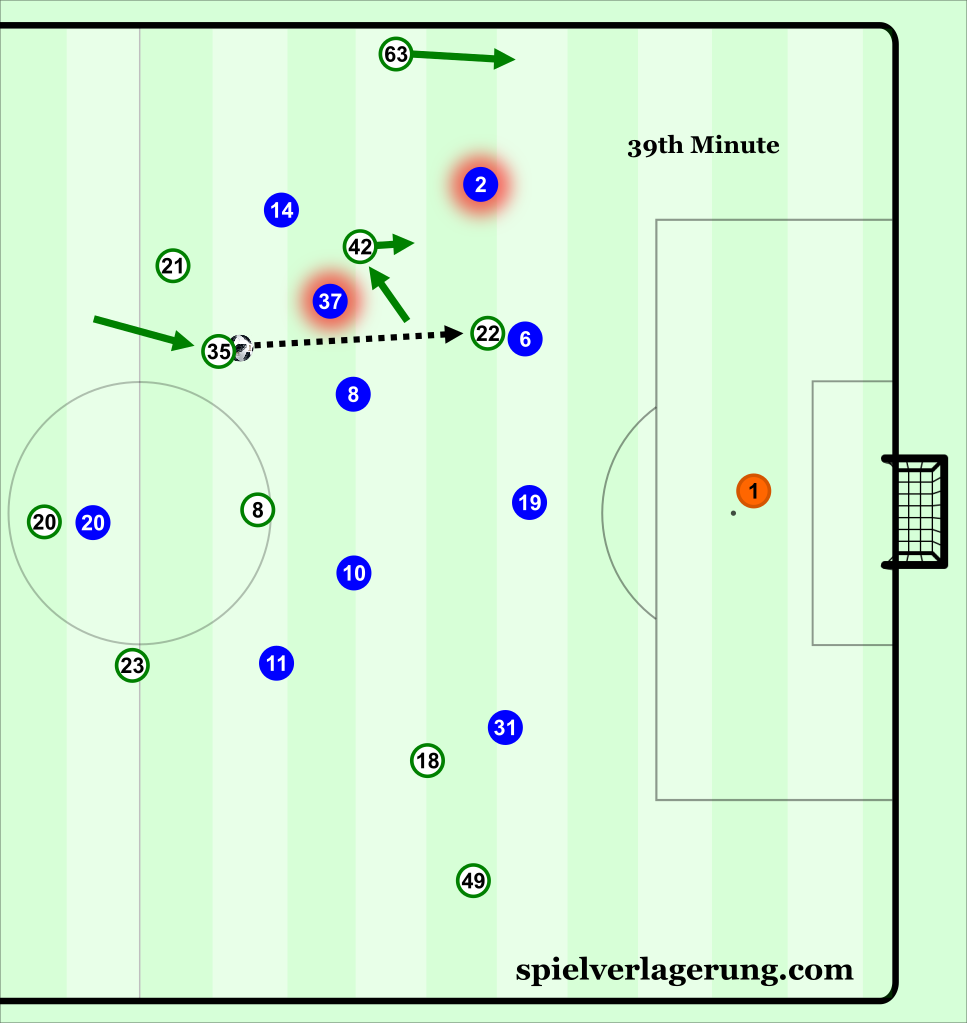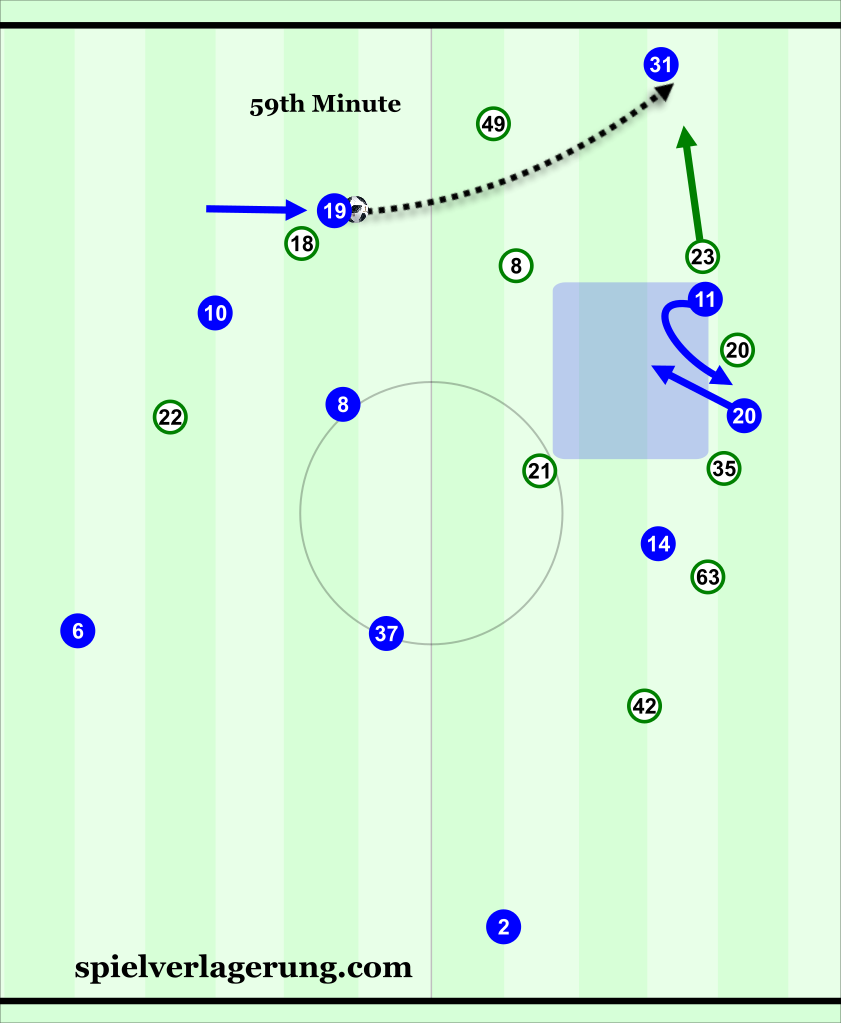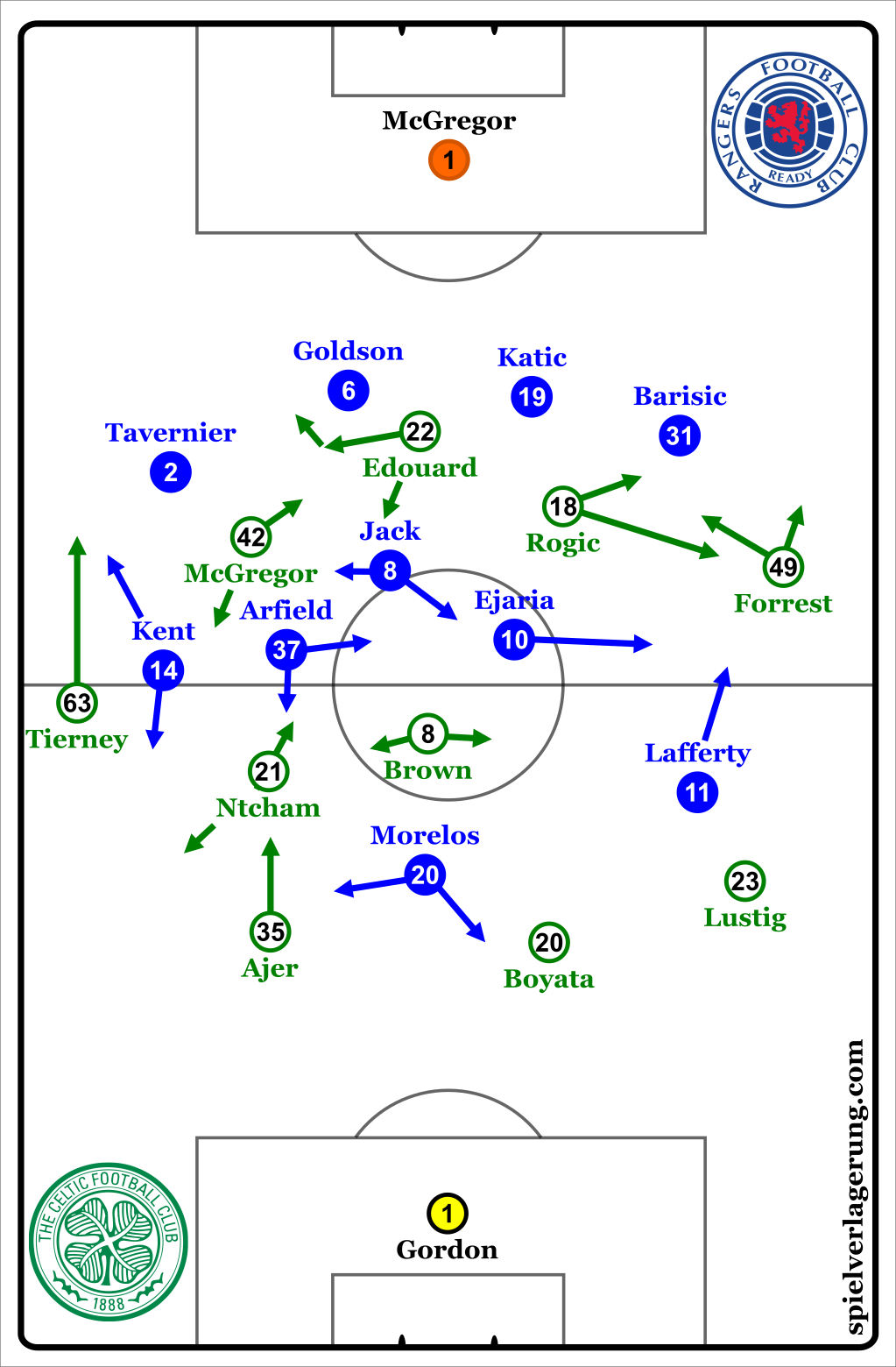Dominant Celtic strike on the counter against Rangers
Steven Gerrard’s Rangers suffered their first loss together at the hands of city rivals Celtic in his first dugout duel with Brendan Rodgers. A stubborn defensive display in the first half was followed by an altogether more expansive game in the second, though ultimately Celtic’s relentless pressure saw them record yet another victory against the Ibrox side.
Congestion on the flank
Rangers’ compact, lop-sided 4-5-1 midfield block creaked slightly under Celtic’s first half pressure without breaking, keeping the champions off the scoresheet before the break. Not unlike their defensive scheme away to Maribor, they sought to force the hosts to the flank before blocking their progression there with intense and compact defending. However, the inclusion of Kyle Lafferty saw Gerrard mimic Rodgers in employing an asymmetric system, with the former Hearts man fulfilling a considerably different role than his right-sided counterpart Ryan Kent.
Kent’s presence and strong ability to threaten interceptions with his clever reading of opponents and excellent acceleration made it difficult for Celtic to integrate Tierney effectively, or indeed safely, in the early stages. The timing of the left back’s advances often took him away from positions where he could receive the ball to feet, even with Olivier Ntcham dropping out to bridge the gap to left centre back Ajer. This weak connection to the flank risked conceding dangerous counter attacks after ball losses in midfield, or even in moments of high pressing from the guests, though such scenarios rarely materialised.
Using Tierney more directly as a depth option was similarly problematic. Callum McGregor’s typical movements from left wing see him play almost exclusively between the lines, as opposed to the benched Scott Sinclair. As such, depth in the left flank was given almost exclusively by Tierney, with Edouard occasionally spinning in behind. However, with Scott Arfield blocking routes to McGregor effectively through his cover shadow, Tavernier was not so strongly compelled to follow the Celtic midfielder as he dropped in off the back line. The Rangers captain was therefore able to hedge his positioning more strongly towards depth balls, making progression for Celtic down the flank exceedingly difficult.
Furthermore, the hosts were largely unable to break through the left with combination play. Of course, this Celtic team is not noted for their strength in this regard, but with Arfield stepping forwards towards the ball-carrier on the left flank to maximise his cover shadow, combined with Tavernier readily stepping back to cover depth, there was opportunity for Brendan Rodgers’ side to play in the space between the two, and launch attacks from there. Indeed, in Edouard and McGregor they had two players around these areas who excel in accelerating play to facilitate the breaking through of an opponent’s back line. However, without consistent and coordinated depth runs to push the defensive line back, they struggled to open this space enough to use it with any great regularity.

Ajer’s aggressive dribble pins Arfield, while McGregor’s space-opening movement allows for Edouard to be introduced between the lines, where he can break through the Rangers midfield. Meanwhile, Tierney and McGregor’s spacing reduces Tavernier’s coverage of potential passing options. Despite the chipped layoff, Celtic create an opening through the free Tierney, leading to Edouard’s good chance.
Despite their massive domination of possession and territory, the result of this congestion down the Rangers right was a procession of slow Celtic attacks, punctuated by the occasional switch to bring Forrest and Rogic into play. This brought Celtic often to the final third, though their attacks typically ended in long shots, set pieces, and crosses against a packed and ready Rangers defence.
Dual roles
Meanwhile Lafferty was positioned distinctly higher on the left. From here he acted almost as auxiliary striker, moving with Morelos to cover the centre as the Colombian pressed on the right, whilst also closing down Lustig when Celtic try to play out through their situational back three. With Celtic’s double pivot of Ntcham and Brown typically so instrumental in their founding of stable possession, Lafferty’s dual role was a way for Steven Gerrard to try to ensure his side were not carved open through the centre.
As well as lightening Morelos’ workload in pressing Celtic’s first line build-up, Lafferty’s pressure from the left served to further direct play towards the well-guarded right. Though this opened up the Rangers left side somewhat, Celtic’s structures and dynamics in possession did not allow them to exploit the larger spaces. With the exception of James Forrest’s diagonal dribbling, the home side had little presence in the right halfspace, as Tom Rogic pushed more towards the right flank. Though the Australian brought Celtic to the final third now and then with his remarkable close control, often evading the attentions of multiple opponents, these situations were difficult to convert into concrete advantages.

Rogic’s central positioning demands the attention of Ejaria and Jack, opening more direct routes diagonally through the middle. If Tierney reads this sooner, Celtic can break through with a dangerous overload on the left side.
Along with diligent backwards pressing from Lafferty, this was in part down to the pressing of Ejaria. With Rogic moving mostly away from the middle, there was little for the on-loan Liverpool midfielder to protect as the left of three central midfielders. This allowed him to act independently from Ryan Jack in a more wide-reaching way, oftentimes as a nominal left midfielder in a situational 4-4-2. From that position he had much better access not only to Rogic, but also to Forrest on the flank, allowing Rangers to congest the right flank just as they did the left.
The deeper and quite passive positioning of Lustig offered some potentially interesting solutions, especially through the pressure it drew from Lafferty, had Celtic occupied the Rangers midfield more effectively. A central Rogic would either prevent Ejaria from moving out to press Forrest, while the Celtic winger’s positioning in line with the Rangers midfield could take him away from Barisic or open large spaces behind the defensive line if the fullback followed him. Cover from Jack would invite quick switches or diagonal actions towards McGregor and Tierney.
Deep eights and counter attacks
While Rangers’ approach with the ball in the first half was somewhat one dimensional, with direct balls to a largely unsupported Lafferty preferred to more stable build-up play through Jack, Gerrard’s tweaks in the second half saw the guests improve in this regard. The deeper positioning of Ejaria and Arfield gave Rangers an even stronger presence in those areas, making stable build-up a less risky and more viable option.
Additionally, with Celtic’s man-orientations in their higher pressing, Brown and Ntcham were frequently pulled away from their defensive line. In the increased space between the lines, Kent was able to move intelligently inwards to receive and attack the defence directly, while Lafferty’s hold-up play was able to be more effective without Brown immediately shutting him down from the front.

Katic dribbling past Rogic brings him onto the midfield line, where he can punch through with a straightforward pass to Barisic – now free from the attention of Forrest. Lafferty’s positioning pins Lustig and Boyata, further opening the position for Rangers.
Meanwhile on the flanks, Rangers were finally able to introduce some of their wing play, though without the usual sophistication and variety. When not found directly, the left side was ably served by Katic dribbling by Rogic before pinning Forrest and playing into Barisic. Lafferty in these moments timed his movement well, staying on Lustig to dissuade the Swedish fullback from jumping onto Barisic, before peeling away to arrive in the box as his teammate received the ball.
From these wide progressions, Rangers primarily looked for crosses, often from deep. Celtic dealt with these comfortably for the most part, with Boyata particularly effective in clearing the box, and ultimately it was the Hoops who benefited most from Rangers’ more aggressive wing play. With Kent and Lafferty playing more centrally in the final third, Gerrard’s fullbacks were largely responsible to hold down their flanks. This saw the far fullback push up as his counterpart delivered crosses, to pick up short clearances or overhit deliveries, thus continuing the attack. However, committing both fullbacks forward was only covered by the two centre backs and one player protecting the space between the box and halfway line.
With such a sparse rest-defence, it came as no surprise that Celtic were able to launch counter attacks without much resistance. To expect Ryan Jack to prevent counter attacks from forming across the whole width of the pitch against a team of Celtic’s calibre is extremely ambitious at best. For comparison, in almost all of Celtic’s games under Rodgers they have operated with a 1-3 rest-defence, with Brown and two others patrolling entry to the middle third. Meanwhile, Thomas Tuchel mentioned that during his time at Dortmund he felt five players were required for an adequate rest-defence.
Conclusion
An assured victory at an important moment for Brendan Rodgers’ side. That Celtic did not win by a greater margin speaks to the performance of Alan McGregor in the Rangers goal, as well as the strong penalty box defending against an unrelenting stream of crosses and corners. Indeed, such was their dominance in the first half that it is perhaps surprising that their only goal came in the second.
Perhaps most significantly, Celtic’s typically high-level performance along with Rangers’ clear tactical plan in the first half and prudent adjustments in the second go to show the development of tactics and strategy in the Scottish game. The effect Brendan Rodgers has had on Scottish football extends further than a widening of Celtic’s trophy cabinet. More and more teams are looking for, and in some cases finding, creative tactical solutions to contain and beat the champions. Hopefully the benefits of a more tactically developed domestic league will translate to the national team. Sooner rather than later.



2 Kommentare Alle anzeigen
Leen September 6, 2018 um 1:56 am
What he says is absolutely correct if your an employee of Sky who have backed a Sevco revival with, rangers legend souness being interview before the match and no Celtic legend?? Every break had Sevco scoring goals through ladbrokes adverts , no sign of Celtic either. Nicholas also had a second stint for us and was mince and we couldn’t lay a glove on the huns, so he knows how McGregor and Lafferty feel, but he doesn’t want that brought up!!☘️
AC October 24, 2018 um 5:23 pm
‘Leen’. What an incoherent rant. Typical.